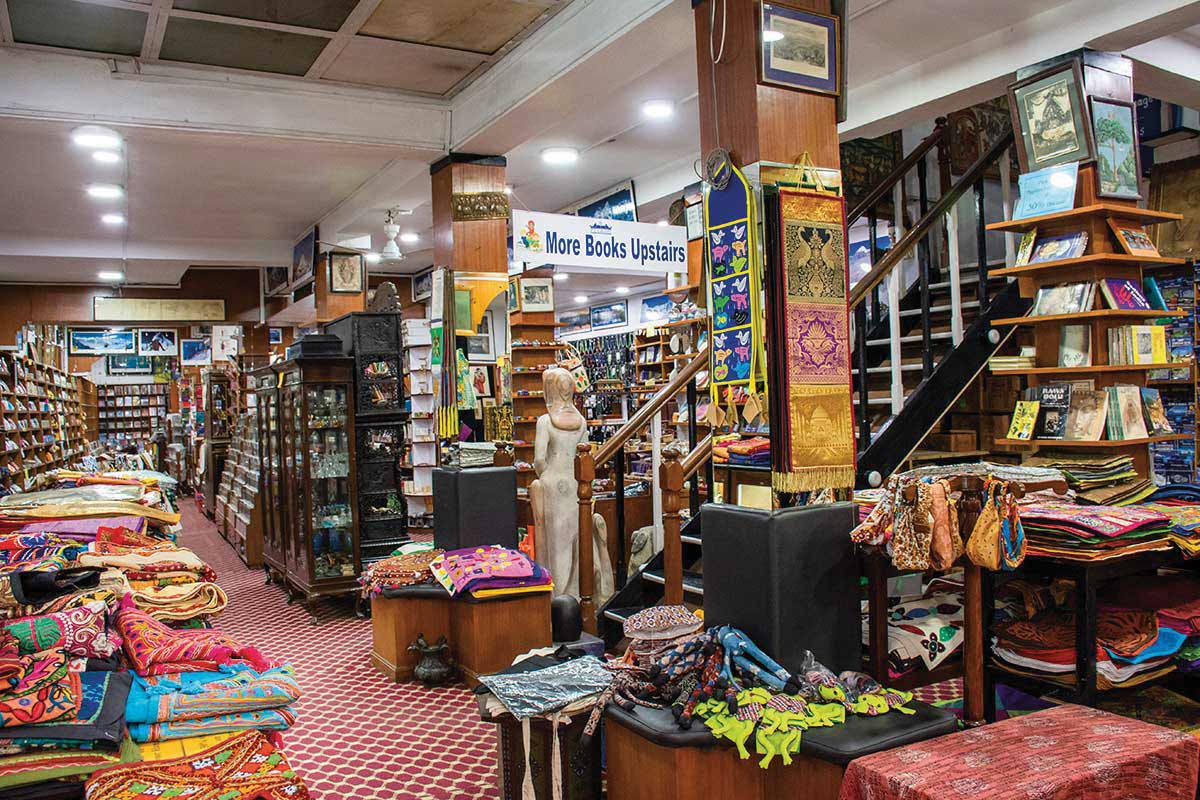Kathmandu’s Sikh community or Satsang has dwindled over the years for various reasons: economic, political and migratory. Yet, a strong connection remains and it is still home for many. Last November saw the 543rd birthday of their founding Guru, Sri Guru Nanak Dev, in a month of celebrations performed with true devotion and eloquent style. Guru Nanak is not just revered on the Indian sub-continent, but also throughout this side of the planet—as a true prophet of God or WaheGuru.
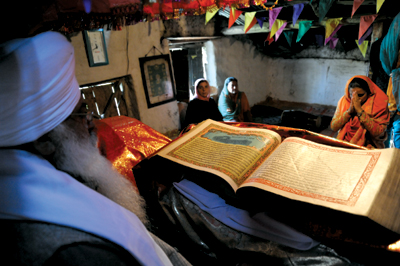
The Guru Granth Sahib or the Sikh Bible is read out for an entire month, attracting scores of Sikh’s.
It was the middle of October, just before the full moon or Purnima of the twenty-third. I was with my Guru-ji, the head of the Badrinath Temple, on the banks of the dreary Bagmati River, in Thapathali. Guru-ji is responsible for maintaining Kathmandu’s original Sikh temple or Gurudwara. A simple stone, brick and mud structure, the temple spans two floors and is painted in earth tones. This building has stood for over 300 years and its simplicity discreetly disguises its history and intent. Inside, Nepal’s oldest copy of the Guru Granth Sahib or Sikh Bible is housed, a 300 year old hand-written copy, resplendent in the finest and brightest of cloths.
Let’s get the show on the road
The run of rituals from Dashain to Tihar had just ended and my exhausted Guru-ji was busy getting the next ready. It would be the first time that the Sikh community were coming together, here, to perform a month long Deep Projolan Puja.
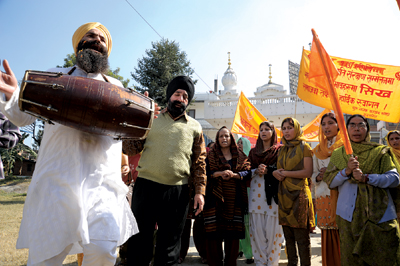
The valley’s sikh’s parade the city to celebrate guru nanak’s birthday
Each day would involve remembering and praising the divine Guru by chanting, playing music and reading from the Guru Granth Sahib, until the next Purnima on his birthday, November 21. It all started by lighting a traditional oil lamp, held in a simple red ceramic bowl, with handmade cotton wicks. The lamp would be dutifully tended by Guru-ji—illuminating an image of the divine Guru Nanak, night and day for a month.
There are over 20 million Sikhs worldwide, of every race and nationality, making it the world’s fifth largest religion. Guru Nanak impressed the Hindus, Muslims, Jains, Sufis and Lamas, amongst others, during his five udasis or journeys into the world. His birthday, therefore, is a worldwide celebration. In my Guru, Sri Mahanta Pushba Das Udasin, I sensed the pride with which he would undertake his duties. He promised himself and WaheGuru not to fail.
A bit about them
Fearsome looking, yet humble in manner, charitable, kind, and quick with a smile is the easiest way to describe a Sikh man. The women have much the same qualities, although the fearsome demeanor is absent! In addition, there is equality between men and women. The traditional Sikh homeland is the Punjab—spanning the border of India with Pakistan. In appearance and habits Sikhs differ from their Hindu and Muslim neighbors. In Sikhism, there are no deities, only God and the Guru’s voice, held within the Guru Granth Sahib. No differences are held between people: neither title, nor caste, sex, color nor religion. All are equal before WaheGuru.
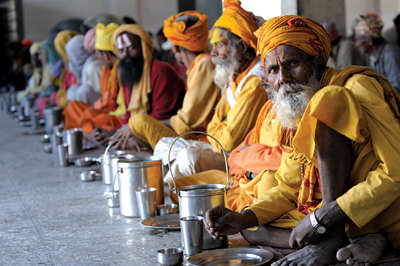
Kupondole’s gurudwara serves free lunch for all to mark this joyous festival
During the last five days of the puja, the Sikh way of praising God is exemplified. Guru Nanak used music with his message, singing through the lands with a devout, harmonious voice. Each morning to initiate the ceremonies, Kathmandu’s Sikhs were out before dawn, singing and marching through the slumbering streets, led by a fearsome looking, black bearded Ganee-ji, or priest, armed with a madal (drum). His shovel like hands pounded out rhythms, and his booming voice echoed harmoniously through dark byways. Love was amplified through this madal basher.
The Sikh’s message of equality is personified through their langars or community kitchens. All visitors eat and sit in the same place, served as equals, sharing simple food cooked in the tantalizing Punjabi style. Community work is the medium for Sikhs to praise WaheGuru, moving on to better karmic cycles.
The Founding Guru
Guru Nanak is believed to be the second most travelled man of early world history, after Morocco’s Ibn Battuta. He moved with the simple message of “there is no Hindu, there is no Musalman”. He was accompanied on all five udasis by a Muslim childhood friend, named Mardana. His companion was a musical maestro and together they sang praise to God around the world. They must have been a strange sight for locals they met, the Guru dressed in his infamous yellow robes and headdress, gleaming like the sun, with Mardana accompanying him on his glorious harmonium.
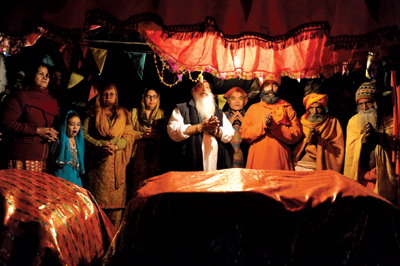
Devotees offer prayers infront of 300 year - old, hand-written bible.
The Guru has been given many names, such as Baba Nanak, Nanak Lama, and Nanak Kalandar, reflecting the distances he traveled.
No stranger to the mountains, he knew the Himalayas intimately. He visited Nepal on his third udasis, from Mt. Kailash in Tibet where mighty Hindu Lord Shiva resides, and which Buddhists believe is at the centre of the universe. Some stories claim that Guru Nanak even climbed it, the only man ever to do so. The Guru came to Nepal and stayed in Thapathali, where his mark remains on old well stones at the Badrinath Temple, run by Guru-Ji and the Udasin Akardha. Udasins are Sadhus, belonging to a sect (akardha), that Guru Nanak’s son, Sri Chandra began. In times of turmoil, during the sixteenth century in India, it fell to the Udasins to protect important Sikh locations and keep daily rituals going.
There is a hill in Balaju, outside the ring road, which is the site of another Udasin Akardha. Here Guru Nanak meditated peacefully and helped ease the mad mind of a Nepali king who came to him looking for solace. The guru also spent time at Basmeshwor, another akardha site in Pashupathinath Temple, on the banks of the Bagmati River.
In Sikhism there are no deities other than God and the Guru, and the guru is within the Guru Granth Sahib. In the Sikh language this is called Gurumuki (Guru’s voice). While accepting and believing many of Sikhism’s principles Udasins also believe in the power of five Hindu deities: Shiva, Shakti, Surya, Ganesh and Vishnu. Guru Nanak did not believe that being the Sikh Guru was something to hand down like a monarchy. This is why Sri Chandra is not one of Sikhism’s ten Gurus. Also, Sri Chandra’s own beliefs were being molded through his yogic, Ayurvedic and Hindu studies. Guru Nanak respected all religions and methods that gave love and devotion to WaheGuru—including his son’s.
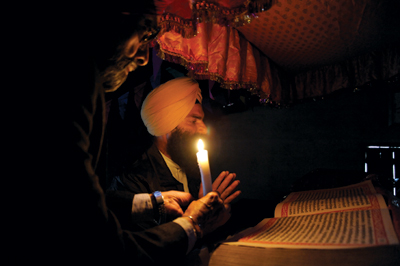 The curtains begin to draw
The curtains begin to draw
For the last three days of the puja, at the main Gurudwara in Kupondole, across the river from Thapathali, their langar heaved with guests, followers and the work involved in making the festivities happen. Gigantic pots of food were prepared and even grander sacks of vegetables peeled, creating three feasts a day, totaling nine colossal feedings.
On the day of the main affair, the Purnima and Guru Nanak’s birthday, there was a boisterous parade through the streets of Kupondole, with banners waving, flowers flying and music emanating harmony. The Kupondole Gurudwara served lunch three times. Ambassadors, government officials and police chiefs were amongst the well-wishers, but even they sat and ate with everyone else.
In the evening, as the sun began its final course, the devout moved as one, across the river to Thapathali, to the lamp, the divine Guru’s image and the ancient Guru Granth Sahib. A final round of hymns and music was made with love and devotion. As the sun set, the lamp was raised and carried outside greeting the full moon as it kissed goodbye to its last day. A procession filled with respectful attention followed the lamp as Guru-ji carried it down to the Bagmati River, where it was laid to rest. In its final position it burned through the night, accompanied by ten smaller lamps representing all Sikhism’s Gurus.
I relaxed as it came to an end. The moon, large, round and lucent, sat against the sky now turning azure. I knew all the Guru-jis could finally rest. It made me warm inside to know that around the globe, simple little lamps were burning bright.
Charlie Das Udasin is a simple Irish sadhu with a love for all the Gurus. Feel free to contact him at charliedasudasin@gmail.com.
Sikhism’s history through its Gurus and the Guru Granth Sahib
1. Guru Nanak – First Sikh Guru, until 1539
Born 20th October 1469, Guru Nanak swiftly mastered Punjabi, Hindi, Sanskrit and Persian. At a young age he began revolting against rituals and caste. He believed all to be equal and never classified himself within a particular religion. He made five great journeys (udasis), taking him around India, Nepal, Tibet, China, Persia and Arabia to Mecca. He shared with all his message of equality, no matter what religion, especially through the langar. He never asked for followers, only that “Muslims be good Muslims and Hindus be good Hindus”.
2. Guru Angad – Guru from 1539 to 1552
Born in 1504, Guru Angad is known for introducing Gurumuki, the written script of Punjabi. He opened schools, reducing illiteracy amongst Sikhs. He kept himself busy collecting Guru Nanak’s details, turning them into a book, as well as writing 62 stanzas of the Guru Granth Sahib. He furthered the langar, as a way of promoting equality.
3. Guru Amar Das – Guru from 1552 to 1574
Born in 1479, Guru Amar Das took the fight for equality to new levels, promoting the langar further, pushing away concepts of caste and untouchability. He changed marriages from being Hindu based, to a new Sikh version, as well as abandoning the Sati ritual, when a widow burns herself upon her husband’s pyre. On top of this he abolished women veiling their faces.
4. Guru Ram Das – Guru from 1574 to 1581
Born in 1534, Guru Ram Das is credited with starting the construction of the Sri Darbar Sahib, Golden Temple in Amristar, Punjab, the centre of Sikhism. It was designed with doors on each side, constantly open to all, from all sides. He also wrote a four stanza hymn that became part of all marriages.
5. Guru Arjan Dev – Guru from 1582 to 1606
Born in 1563, the third son of Guru Ram Das, Guru Arjan Dev is held as Sikhism’s finest writer and practitioner. He not only completed the Sri Darbar Sahib, but also the main body of the Guru Granth Sahib. A number of Muslim and low caste Hindu poems were included, giving the book a more universal message. He was the first martyr of Sikhism, executed by the Moghul Emperor, Jahangir.
6. Guru Har Gobind – Guru from 1606 to 1644
Born in 1595, the son of Guru Arjan Dev is credited with forming the Sikh army and establishing the principle of Miri-Piri, the wearing of two swords, symbolizing temporal and spiritual authority. He believed that practicing non-violence left one open to attack and it was necessary to protect each other, but with a strict policy of no first aggression.
7. Guru Har Rai – Guru from 1664 to 1661
Born in 1630, Guru Har Rai led a pious life, mostly meditating. He neither expanded nor depleted the soldier-saints started by his grandfather, Guru Har Gobind. He focused on perfecting the Sikh nation, which was then being monitored by the Moghul Emperor, Aurangzeb.
8. Guru Har Krishna – Guru from 1661 to 1664
Guru Har Krishna was five years old when recognized as embodying the virtues of Sikhism. He spent most of his time helping those dying from an epidemic in Delhi. The sufferers, mostly Muslim, dubbed him the “little prophet”. The Emperor Aurangzeb thought best not to meddle and let him be.
9. Guru Tegh Bahadur - Guru from 1665 to 1675
Born in 1631, Guru Tegh Bahadur established the town of Anandpur, but is most renowned for being martyred, defending the pandits (priests) of Kashmir. Aurangzeb was forcibly converting them, believing that millions of Hindus would follow. However, a pandit dreamt of Lord Shiva telling him visit the Sikh Guru. Upon hearing their plight, he began defending their right. This brought Aurangzeb’s anger upon him, and he was arrested, tortured for four months and finally beheaded in Delhi. A massive storm blew up after his execution, and under its cover a devoted Muslim took the Guru’s body to his nearby house and secretly cremated him—by burning his own home. He then secretly transported his head to Anandpur. Many pandits after this sacrifice converted to Sikhism, and the Guru became known for his slogan “fear not and frighten not”.
10. Guru Gobind Singh – Guru from 1675 to 1708
Born in 1708, Guru Gobind Singh is credited with making the Sikh nation what it is today. After the martyrdom of his father Guru Tegh Bahadur, he pushed the idea of soldier-saints defending the oppressed. His greatest legacy other than finalizing the Guru Granth Sahib, was creating the Khalsa, bonding Sikhs in a casteless and nationless way. He created the 5 k’s, five symbols of Sikhism: Kesh (uncut hair), Kara (steel bracelet), Kanga (wooden comb), Kaccha - (cotton underwear) and Kirpan (steel blade). He fought battles with harassing local Rajas and won. After, Anandpur was besieged, and for a long time defiantly resisted. A truce was made, and an offer to leave Anandpur safely was given and promised upon the holy Quran. But, as the inhabitants left, they were set upon and butchered. The Guru and few others escaped, fighting running battles—he lost all his family. Guru Gobind Singh wrote the Zafarnamah (the Epistle of Victory), to Aurangzeb, citing him for breaking holy oaths. Soon after receiving this letter Aurangzeb died, and the Sikhs sided with the more liberal choice for the throne, Prince Muazzam, and won. For this, an attempt was made on the Guru’s life by another Mughal lord. The Guru was injured and he slowly succumbed to his wounds. He decreed as he died that no more Gurus would follow, and all the knowledge the people required was there for them within the Guru Granth Sahib.
Nepal’s Sikh Population—Now and Then
Nepal is not just home to Indian Sikhs, but many a Nepali Sikh too, as well as American, European and Asian Sikhs. A good example of this is the short, stocky, white bearded Ganee-ji residing at Kupondole’s Gurudwara. His family originates from outside Pokhara, and they have been practicing Sikhism for generations.
The size of the original Gurudwara (in Thapateli), says much of the Sikh population that lived here 300 years ago. Considering that only 50 odd devotees can sit inside at a time, it is safe to say the population was small. But, in 1934, Kathmandu was struck by a terrible earthquake, with vast damage to this ancient, fragile city. In response, India sent help for rebuilding. Sikhs are excellent engineers and transporters, so with this reconstruction many ended up here, and some never quite left.
The city was rebuilt, slowly returning to normal. Outside of the valley, many Sikhs took up residence in the tarai, bordering India, in places like Birgunj, Biratnagar and Nepalgunj—mostly with transport companies and engineering businesses. Recent years saw the civil war, as well as the political instability that followed. This didn’t bode well for business and many Sikhs began migrating back to India. Yet quite a few have remained, calling Nepal home.


